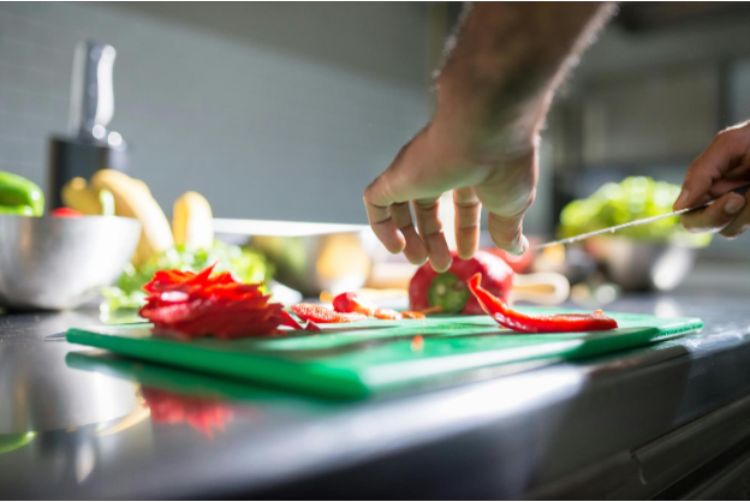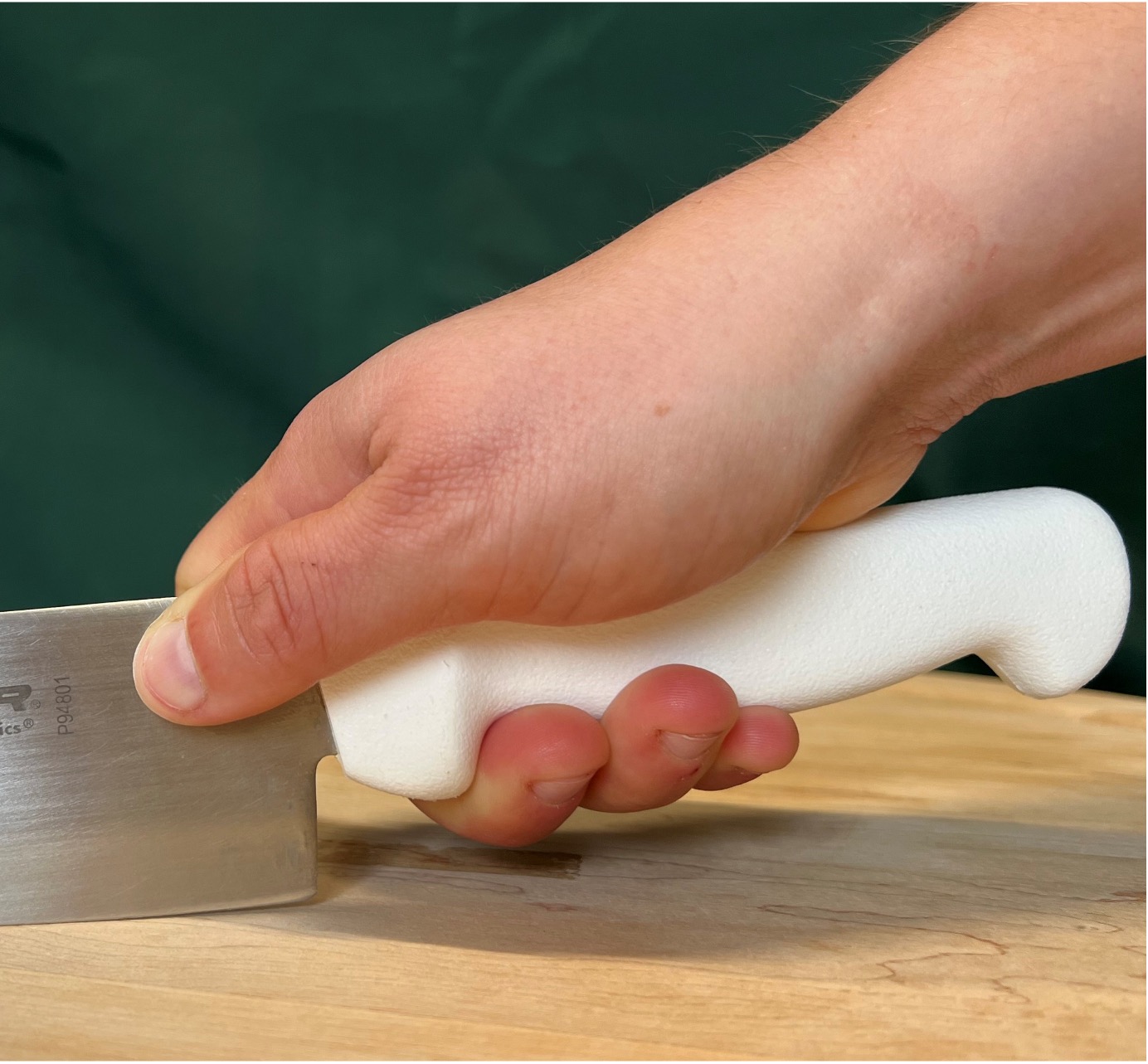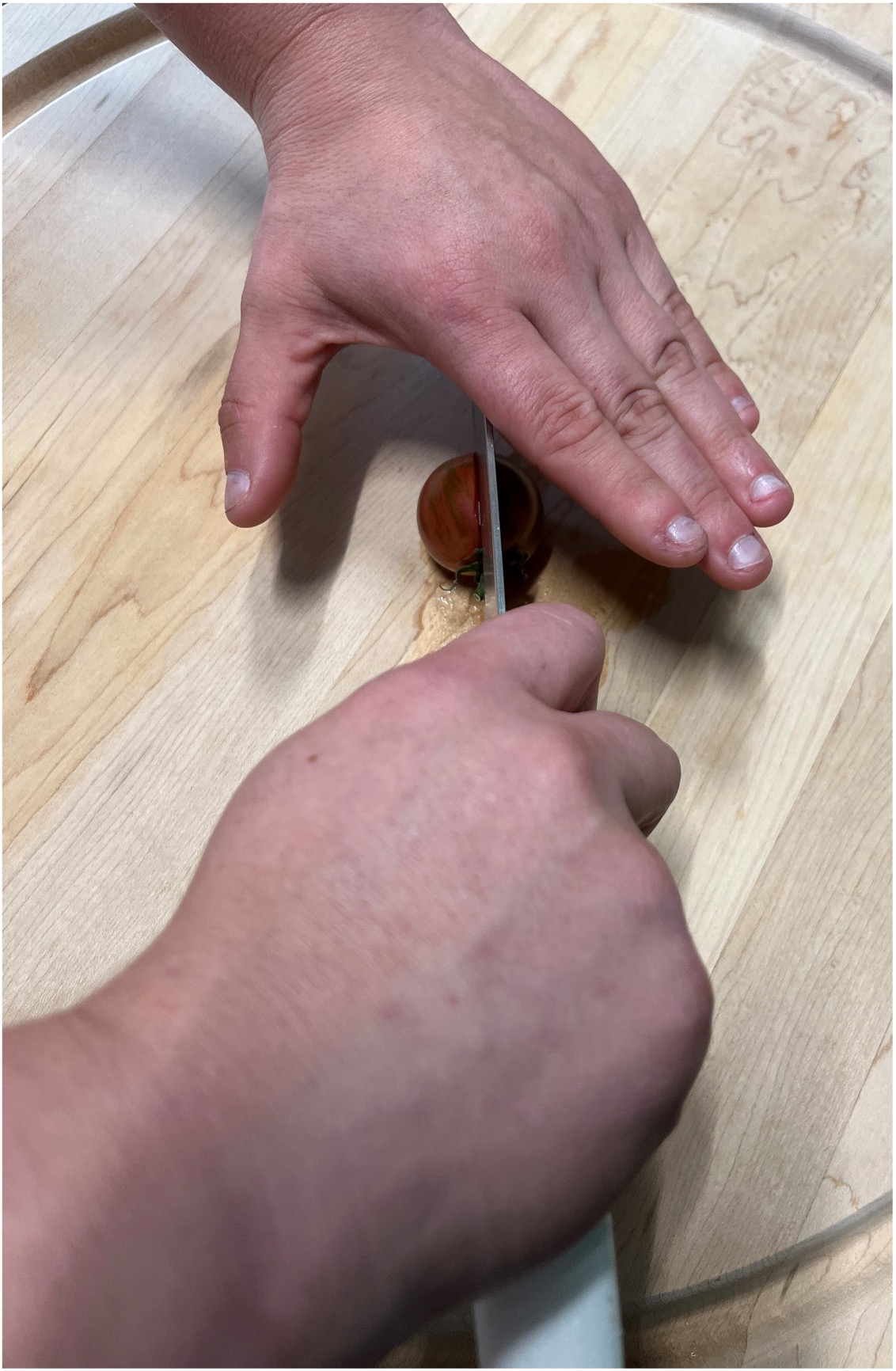Handling knives safely
A knife can make kitchen tasks easier if they are handled safely.

Handling knives
Whether a knife is used to cut carrots or sitting in a knife block, always give knives your full respect. Knives can be intimidating and knowing how to use them safely will minimize injuries. With a sharp blade, the knife does the work, that is, if it is held correctly.
Other considerations are knowing the different parts of a knife, how to sharpen and what to cut it on.
Holding knives
There are a few ways to hold a knife correctly. The first is, with the dominant hand, take the thumb and forefinger and pinch the blade (the back part of the blade), and the last three fingers curl around the handle. If the knife has a bolster, it acts as a guard, keeping the fingers on the handle from slipping under the blade. Pinching the heel of the blade will provide complete control over where the knife goes. The other way to safely handle a knife is to have all four fingers curl around the handle, and the thumb stays on the side of the knife closest to you. If it is uncomfortable, a different type of knife may be necessary.

NO pointy fingers on the spine of the knife! This causes too much pressure on the blade, and if it slips, it can cause injury. A good grip is needed, not extreme pressure. This lets the knife do the work. If you use a strong grip, you will be doing the work. Remember, you are in control of the knife.

Holding food
Having a stable surface for cutting fruits and vegetables will also lower the risk of injury. But what shape are most fruits and vegetables? This is why the first cut should be “get to flat first.” This creates a stable surface to place on the cutting board.
To hold food, the claw method is the recommended way of keeping fingers away from the knife blade. It may be very uncomfortable at first. For the hand holding the food, the area between each finger’s middle knuckles to the knuckles nearest to the fingernail will act as a guide, allowing the flat part of the knife blade to rest against. This allows the hand to know where the knife is and to control where it is going. Moving along the food, the thumb should always be in retreat mode, behind the rest of the fingers.
If the knife blade is still intimidating, there is another option where the hand does not hold the food. A larger knife is best for this strategy. For the first cut, “get to flat first,” insert the knife blade gently into the food. Make the opposite hand flat and place the palm on the spine of the knife. This allows the hand and fingers to stay away from the sharp edge of the knife. The hand holding the knife will keep it steady as the opposite hand pushes down, helping the blade slice through the food. This hand can provide a little pressure when going through hard things, but not too much pressure. Let the knife do the work.
When using a smaller knife, it is very tempting to use the hand as a cutting surface. And yes, if the hand is used as a cutting surface, there is a greater risk of injury. Using a cutting board is always preferred, and if this isn’t an option, be very careful with the knife.
Storage
To keep knives in the best condition, store them in a knife block that is upright and sits on the countertop or a knife block that fits in a drawer. Steel knives can be stored on a magnetic strip hung on a wall. Storing knives in a drawer without protection will dull the blades quickly and create a hazard when reaching for another kitchen tool.
Cut-resistant gloves
Cut-resistant gloves made with metal mesh or Kevlar fabric may decrease the risk of injuries. If the knife slips, the glove may stop the blade from cutting a finger or the hand. These gloves are also handy when using graters or micro-planers. Care still needs to be taken when wearing this type of glove. Misuse of the knife can still cause injury even with the gloves on.
Washing knives
MSU Extension recommends washing knives immediately after using them. Knives should also be washed before using on a different type of food to prevent cross-contamination.
Always know where a knife is when working in the kitchen. Placing knives in a sink full of sudsy water can be dangerous and can cause injury. It’s easy to forget a knife at the bottom of the sink when reaching for other items. Additionally, any pots, pans, and tableware in the kitchen sink will bump into the knife and dull the blade.
Dishwashers are not recommended for cleaning knives. Dishwasher detergent is corrosive and can damage the knife blade and handle.
More than holding a knife
Holding a knife correctly may become automatic with practice. Always use a comfortable speed, as too fast may result in a visit to the emergency room. When working with knives, focus on the task. Injuries are more likely to happen when there are distractions.
When moving from one area of the kitchen to another, hold the knife down and pointed towards the floor. Let others know when you are moving a knife. A simple “knife on the move” will alert others.
When giving someone a knife, it is best to lay it down and let the other person pick it up. Never try to catch a falling knife.
To keep a knife sharper longer, use the spine of the blade to scrape food off a cutting board. Another option is to use a bench scraper or a bowl scraper. There are several options to sharpen knives in the home kitchen. A dull knife is unfriendly and unsafe in the kitchen.



 Print
Print Email
Email



